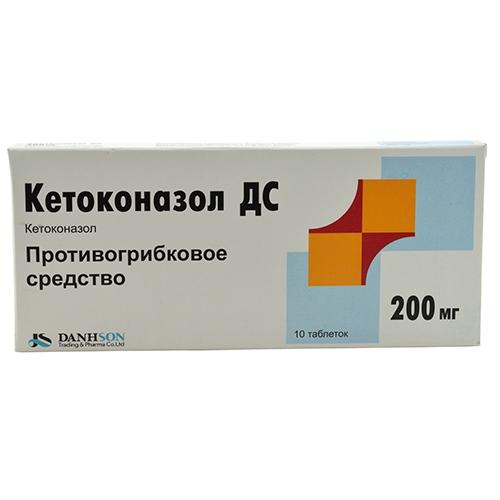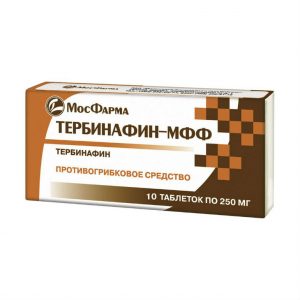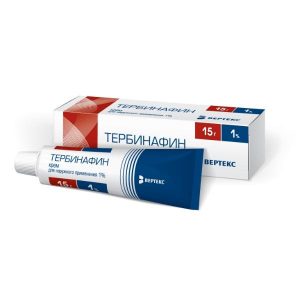Description
packaging 10 pcs
Pharmacological action
Ketoconazole is an antifungal agent. It has fungicidal and fungistatic effects. The mechanism of action is to inhibit the synthesis of ergosterol and change the lipid composition of the membrane.
Active against the causative agent of multicolor lichen Malassezia furfur, pathogens of some dermatomycoses (Trichophyton, Epidermophyton floccosum, Microsporum), candidiasis pathogens (Candida), as well as pathogens of systemic mycoses (Cryptococcus).
Also active against gram-positive cocci: Staphylococcus spp., Streptococcus spp.
Pharmacokinetics
Ketoconazole is a weak dibasic compound that dissolves and is absorbed in an acidic environment. Cmax of ketoconazole in plasma is about 3.5 μg / ml and is achieved 1-2 hours after a single oral dose of 200 mg with meals.
The bioavailability of ketoconazole is maximal when taken with food. The absorption of ketoconazole is reduced in patients with reduced acidity of gastric juice, for example, taking antacid drugs such as aluminum hydroxide, and antisecretory drugs, such as histamine H2 receptor blockers and proton pump inhibitors, as well as in patients with achlorhydria caused by terminal illness.
Binding to plasma proteins, mainly to the albumin fraction, is 99%. Ketoconazole is widely distributed in the tissues, but only a small part of the drug penetrates into the cerebrospinal fluid.
After absorption from the digestive tract, ketoconazole is metabolized in the liver to form a large number of inactive metabolites.
In vitro studies have shown that the isoenzyme CYP3A4 is involved in the metabolism of ketoconazole. The main metabolic pathways are the oxidation and cleavage of the imidazole and piperazine rings, oxidative O-dealkylation and aromatic hydroxylation. Ketoconazole is not an inducer of its own metabolism. Excretion from plasma is two-phase: during the first 10 hours, T1 / 2 is 2 hours, then 8 hours.
About 13% is excreted in the urine, of which 2-4% is unchanged. It is excreted mainly with bile in the digestive tract and about 57% is excreted with feces.
Indications
Blastomycosis, coccidioidomycosis, histoplasmosis, chromomycosis, paracoccidioidomycosis.
Contraindications
Hypersensitivity, pregnancy, lactation.
Special instructions
When administered orally, it is necessary to regularly monitor the picture of peripheral blood, the functional state of the liver and kidneys.
If GCS was used to treat skin lesions, ketoconazole should be prescribed no earlier than 2 weeks later.
Composition
1 tablet contains:
Active ingredient:
ketoconazole 200 mg.
Dosage and administration
For oral administration to adults and children weighing more than 30 kg – 200-400 mg / day.
For children weighing less than 30 kg – 4-8 mg / kg / day.
Take 1 time per day with meals.
Side effects
From the nervous system: headache, dizziness, paresthesia, drowsiness, increased irritability, insomnia, anxiety, fatigue, general weakness, reversible increase in intracranial pressure (for example, edema of the optic nerves, swelling of the fontanel in young children).
From the digestive system: nausea, abdominal pain, diarrhea, impaired liver function, vomiting, dyspepsia, constipation, dry mouth, dysgeusia, bloating, discoloration of the tongue, toxic hepatitis (increased
activity of hepatic transaminases or alkaline phosphatase, jaundice, severe hepatotoxicity, including cholestatic hepatitis, hepatonecrosis (biopsy), cirrhosis, liver failure (including cases of transplantation and death)
Metabolism: alcohol intolerance, anorexia, hyperlipidemia, increased appetite .
From the musculoskeletal system: myalgia, arthralgia.
From the respiratory system: epistaxis.
From the skin and subcutaneous fat: alopecia, dermatitis, erythema, erythema multiforme, pruritus, rash, xeroderma, hot flashes, acute generalized exanthematous pustulosis, photosensitivity.
From the cardiovascular system: orthostatic hypotension.
On the part of the endocrine system: gynecomastia, adrenal insufficiency, menstrual irregularities, a temporary decrease in testosterone concentration in the blood plasma is possible (normalized 24 hours after administration).
From the sense organs: photophobia.
Allergic reactions: rash, urticaria, anaphylactic shock, anaphylactic reactions, angioedema.
From the side of the immune system: pseudo-anaphylactic shock.
From the reproductive system: erectile dysfunction, azoospermia (at doses exceeding therapeutic – 200-400 mg / day).
On the part of laboratory parameters: a decrease in the number of thrombocytopenia.
General reactions: fever, peripheral edema, chills.
Drug interaction
With the simultaneous use of ketoconazole with antacids (aluminum hydroxide, histamine H2 receptor blockers, proton pump inhibitors), the absorption of ketoconazole from the gastrointestinal tract decreases. With these combinations, the antifungal activity of ketoconazole should be monitored and, if necessary, dose adjusted.
With the simultaneous use of ketoconazole with powerful inducers of the isoenzyme CYP3A4, the bioavailability of ketoconazole is possible, which can cause a significant decrease in its effectiveness. Such drugs include isoniazid, rifabutin, rifampicin, carbamazepine, phenytoin, efavirenz, nevirapine. If these combinations cannot be avoided, then the antifungal activity of ketoconazole should be monitored and, if necessary, increase its dose.
With the simultaneous use of ketoconazole with powerful inhibitors of the CYP3A4 isoenzyme (for example, antiviral drugs, including ritonavir, ritonavir-enhanced darunavir and ritonavir-enhanced fosamprenavir), the bioavailability of ketoconazole may increase. With these combinations, the patient’s condition should be monitored to identify symptoms of increased intensity and duration of action of ketoconazole, the concentration of ketoconazole in blood plasma and, if necessary, reduce its dose.
With the simultaneous use of ketoconazole is able to inhibit the CYP3A4-mediated metabolism of drugs, as well as the transport of active substances due to P-glycoprotein. This can lead to an increase in the concentration of these drugs in plasma and / or from active metabolites, which causes an increase in the intensity and duration of therapeutic or side effects of the drugs used simultaneously.
The simultaneous use of the following drugs with ketoconazole is not recommended: tamsulosin, fentanyl, rifabutin, rivaroxaban, carbamazepine, dasatinib, nilotinib, trabectin, salmeterol. If these combinations cannot be avoided, then clinical monitoring of the patient’s condition should be provided to identify symptoms of an increase in the intensity or duration of therapeutic and / or side effects, control the concentration of the drug in the blood plasma and, if necessary, reduce the dose of the corresponding drug or suspend its use.
With caution, ketoconazole should be used simultaneously with the following drugs: alfentanil, buprenorphine (iv and sublingual), oxycodone, digoxin, coumarins, cilostazole, repaglinide, saxagliptin, praziquantel, ebetribin borbentome, eletriptan borbentome, ixabepilone, lapatinib, trimerexate, vinca alkaloids, alprazolam, aripiprazole, brotizolam, buspirone, haloperidol, midazolam (iv), perospiron, quetiapine, ramelterone, risperidone, maraviroc, indinavir, saquinavir, nadolol, verapamil, aliskiren, aprepitant, budesonide, ciclesonide, cyclosporine, dexamethasone, fluticasone, methylprednisolone, sirolimus, tacrolimus, temsirolimus, atorvastatin, reboxetine, fesoterodine, imidafenatsin, sildenafil, solifenacin, tadalfil, tolterodine, alitretinoin (oral dosage form), cinacalcet, mozavaptan, tolvaptan. With joint use, careful monitoring of the patient s clinical condition is recommended, if necessary, monitoring the concentration of the drug in the blood plasma and, if necessary, reducing its dose.
In isolated cases, a disulfiram-like reaction is possible when drinking alcohol while taking ketoconazole.
Storage Conditions
In a dark place at a temperature below 25 ° C.
Deystvuyuschee substances
Ketoconazole
Pharmacy
Pharmacy Terms
Form of Treatment
tablets




